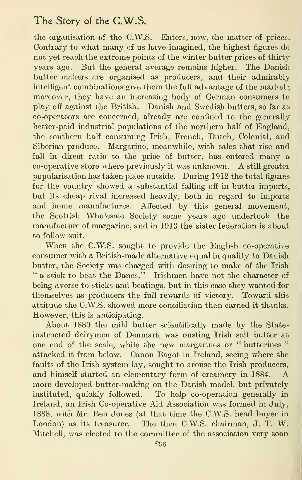Page 374 - The_story_of_the_C._W._S._The_jubilee_history_of_the_cooperative_wholesale_society,_limited._1863-1913_(IA_storyofcwsjubill00redf) (1)_Neat
P. 374
;
The Story of the C.W.S,
the organisation of the C.W.S. Enters, now, the matter of prices.
Contrary to what many of us have imagined, the highest figures do
not yet reach the extreme points of the winter butter prices of thirtj'
years ago. But the general average remains higher. The Danish
butter makers are organised as producers, and their admirably
intelligent combinations give them the full advantage of the market
moreover, they have an increasing body of German consumers to
play off against the British. Danish and Swedish butters, so far as
co-operators are concerned, already are confined to the generally
better-paid industrial populations of the northern half of England,
the southern half consuming Irish, French, Dutch, Colonial, and
Siberian produce. Margarine, meanwhile, with sales that rise and
fall in direct ratio to the price of butter, has entered many a
co-operative store where previously it was unknown. A still greater
popularisation has taken place outside. During 1912 the total figures
for the country showed a substantial falhng off in butter imports,
but its cheap rival increased heavily, both in regard to imports
and home manufactures. Affected by this general movement,
the Scottish Wholesale Society some years ago undertook the
manufacture of margarine, and in 1913 the sister federation is about
to follow suit.
When the C.W.S. sought to provide the EngHsh co-operative
consumer with a British-made alternative equal in quaUty to Danish
butter, the Society was charged with desiring to make of the Irish
" a stick to beat the Danes." Irishmen have not the character of
being averse to sticks and beatings, but in this case they wanted for
themselves as producers the full rewards of victory. Toward this
attitude the C.W.S. showed more conciliation than earned it thanks.
However, this is anticipating.
About 1880 the mild butter scientifically made by the State-
instructed dairymen of Denmark was ousting Irish salt butter at
"
one end of the scale, while the new margarines or " butterines
attacked it from below. Canon Bagot in Ireland, seeing where the
faults of the Irish system lay, sought to arouse the Irish producers,
and himself started an elementary form of creamery in 1884. A
more developed butter-making on the Danish model, but privately
instituted, quickly followed. To help co-operation generally in
Ireland, an Irish Co-operative Aid Association was formed in July,
1888, with Mr. Ben Jones (at that time the C.W.S. head buyer in
London) as its treasurer. The then C.W.S. chairman, J. T. W.
Mitchell, was elected to the committee of the association very soon
296

